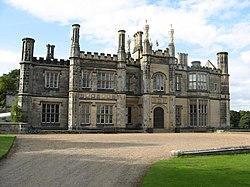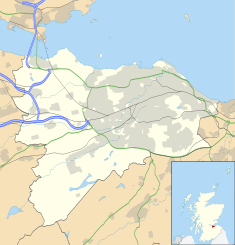Dalmeny House
| Dalmeny House | |
|---|---|

Dalmeny House, south front
|
|
| Location | Dalmeny, Edinburgh, Scotland, United Kingdom |
| Coordinates | 55°59′17″N 3°20′03″W / 55.988°N 3.3343°WCoordinates: 55°59′17″N 3°20′03″W / 55.988°N 3.3343°W |
| Built | 1817 |
| Built for | Archibald Primrose, 4th Earl of Rosebery |
| Architect | William Wilkins |
| Architectural style(s) | Tudor Gothic Revival |
|
Listed Building – Category A
|
|
| Designated | 22 February 1971 |
| Reference no. | 82 |
| Criteria | Work of Art Historical Architectural Scenic Nature Conservation |
| Designated | 1987 |
Dalmeny House is a Gothic revival mansion located in an estate close to Dalmeny on the Firth of Forth, to the north-west of Edinburgh, Scotland. It was designed by William Wilkins, and completed in 1817. Dalmeny House is the home of the Earl and Countess of Rosebery. The house was the first in Scotland to be built in the Tudor Revival style. It provided more comfortable accommodation than the former ancestral residence, Barnbougle Castle, which still stands close by. Dalmeny today remains a private house, although it is open to the public during the summer months. The house is protected as a category A listed building, while the grounds are included in the Inventory of Gardens and Designed Landscapes in Scotland.
In the 13th century, the estate was the property of the Mowbray family, who built Barnbougle Castle. The estate was acquired in 1662 by Sir Archibald Primrose, whose son was created Earl of Rosebery in 1703. In 1774 Neil Primrose, 3rd Earl of Rosebery, commissioned Robert Adam to design a new house at Barnbougle, and in 1788 Robert Burn also provided designs. However, the Earl concentrated on the estate, carrying out woodland planting and constructing a walled garden. The son of the 3rd Earl, Archibald Primrose, commissioned further plans in the early 19th century: from William Atkinson (1805) and William Burn (1808). Again nothing was done until Archibald succeeded as 4th Earl of Rosebery in 1814. He then turned for a new house to Jeffrey Wyatt, who provided a Tudor Gothic design. Lord Rosebery approved, but wished to employ William Wilkins, with whom he had attended Cambridge. Wilkins was therefore asked for a Tudor Gothic design, which was eventually built in 1817. The design of the house draws on the 16th-century East Barsham Manor in Norfolk. From 1812 the designed landscape around the house was also laid out, to designs by Thomas White Jr.
...
Wikipedia

